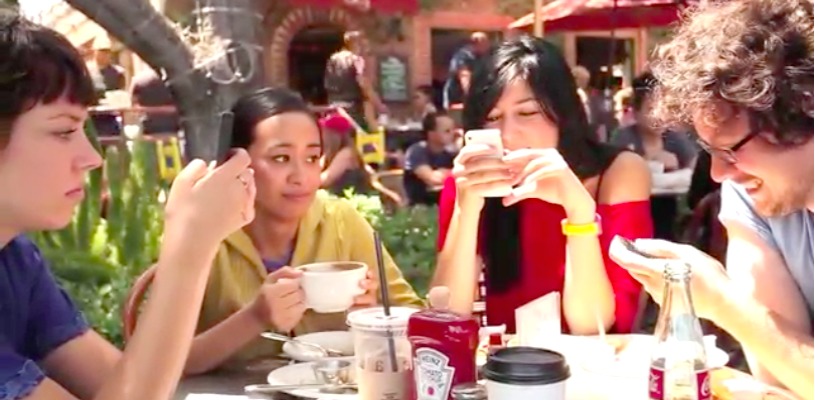10 Media Revelations
1. Technology and Internet have become entwined with almost every part of life. Due to the convergence of media onto single formats such as computers, phones, or tablets mass amounts of information can be accessed anywhere at any time. No matter where a person is they can be accessing their favorite kinds of media that are suited to their tastes and their lifestyles.
- “With new technologies allowing access to more media options than ever, mass audiences are morphing into audience subsets that chase particular lifestyles, politics, hobbies, and forms of entertainment (Campbell, 11).”
- For much of their history, media companies have been part of usually discrete or separate industries…But the Internet and convergence has changed that-not only by offering a portal to view or read older media forms but also by requiring virtually all older media companies to establish an online presence (Campbell, 467).”
- http://www.pbs.org/wgbh/pages/frontline/digitalnation/view/
2. The idea that “newspapers are dying, not news.” Newspapers are on the decline because advertisers have taken their money away from print and moved it to the more targeted digital advertising available online. Without the money coming in from advertising the newspapers needed to accept defeat or move into the digital age. However, even if the newspaper dies, the industry itself will not. No matter what form the news comes in, it will always be in demand from consumers.

- “Remarkably, while the United States continues to experience declines in newspaper readership and advertising dollars, many other nations-where Internet news is still emerging-have experienced increases (Campbell, 301).”
- “While some observers think newspapers are on the verge of extinction as the digital age eclipses the print era, the industry is no dinosaur (Campbell, 304).”
- http://www.magpictures.com/pageone/
3. The behavior of youth can be altered by media. Several studies have shown that when children view violent films or video games, in the short run, they will then behave in a similar manner. Their buying behavior can also be influenced by advertisements. The ads get in their head at a young age by targeting them with fun characters or warm fuzzy scenes. Now that society is aware of these influences they have created things such as movie ratings, advertising restrictions, and age limits on product purchasing.

- “Because the groups were randomly selected and the only measurable difference between them [two groups of 10 year old boys] was the viewing of the movie, researchers may conclude that under these conditions the violent film caused a different behavior (Campbell, 529).”
- “A Stanford University study found that a single thirty-second TV ad can influence the brand choices of children as young as age two (Campbell, 407).”
- http://www.pbs.org/wgbh/pages/frontline/generation-like/
4. Advertising most heavily targets the limbic brain. The limbic brain is the section of the brain that processes music and images. For this reason advertising most dominantly appeals to the feeling brain through song choices, nostalgic scenes, or emotional situations. The limbic brain can relate to the moods or stories that advertisements often depict as well as make the association with personal experiences.
- “Most consumer ads, however, merely create a mood or tell stories about products without revealing much else (Campbell, 399).”
- “This type of advertising exemplifies the association principle, a persuasive technique used in most consumer ads that associates a product with a positive cultural value or image even if it has little connection to the product (Campbell, 400).”
- https://www.youtube.com/watch?v=Lv-sY_z8MNs (2013)
5. Increased use of technology can come with possible social costs. It is hard to distinguish if media has altered society or enhanced existing characteristics, but either way it has changed the way people interact with one another. Media has the power to become a distraction from life in the moment, taking up large amounts of people's time and energy. The distance being created by some media has been blamed for reductions in culture and appreciation for classic art forms.


- “Yet how much the media shape society-and how much they simply respond to existing cultural issues- is still unknown(Campbell, 16).”
- “Sometimes called the “Big Mac” theory, this view suggests that people are so addicted to mass produced media menus that they lose their discriminating taste for fine fare and, much worse, their ability to see and challenge social inequalities (Campbell, 24).”
- https://www.youtube.com/watch?v=OINa46HeWg8 (I forgot my phone)
6. Privacy is quickly disappearing in the digital age. Today everything that is done on the Internet has the potential to be monitored by advertisers, governments, and other various industries. Therefore, what you do is never very private. Everything that is clicked on or sent can be collected, evaluated, and filed away in a profile. Even the information that is put out by you has the potential of spreading beyond your knowledge and staying there.


- “However, when you use the Internet, whether you are signing up for an email account, shopping online, or even just surfing the Web, you give away personal information-voluntarily or not (Campbell, 68).”
- “And given the endless archives of the Internet, such images never really go away but can be accessed by anyone with enough skills to find them (Campbell, 559).
- https://www.youtube.com/watch?v=SdezJrNaL70 (we steal secrets)
7. Advertisers often use consumers to do their job. Through social media advertisers are able to get consumers to show them exactly what they like by clicking on some ads and ignoring others. When a consumer finds something they like, they will advertise for the agencies by liking it, sharing it, or even making videos about it. Social media allows for consumers to take part in the products and have the opportunity to become known for liking a product so much.
- “For advertisers-who for years struggled with how to measure people’s attention to ads- these activities [social networking] make advertising easy to track, effective in reaching the desired niche audience, and relatively inexpensive because ads get wasted less often on the uninterested (Campbell, 66).”
- “Social media are helping advertisers use such personal endorsements to further their own products and marketing messages- basically, letting consumers do the work for them (Campbell, 398).”
- http://www.pbs.org/wgbh/pages/frontline/generation-like/
8. The switch from mass to personal has greatly influenced how we relate to technology. In the past newspapers or TV shows were distributed to everyone at the same time, with few options. But today there is a TV show, music genre, gaming system, and social media site for every person’s specific preference. Media is no longer delivered on a mass basis, but on a person by person basis that is designed to give a special experience for those who use it. Individuals can decide exactly what media they want to see and what they don’t want to see.
- “While these options allow us to connect with friends or family and give us more choices, they also break down shared media experiences in favor of our individual interests and pursuits (Campbell, 13).”
- “Some media critics even posit that having more choice actually makes us more engaged media consumers, because we have to actively choose the media we want to consume from the growing list of options (Campbell, 14).”
- https://www.youtube.com/watch?v=v76f6KPSJ2w (Christmas)
9. Social media has become a major player in society. Facebook in particular has the ability to alter the way we interact with other people. We can like, share, or comment on people’s photos and lives at any point. We can make our own opinions and thoughts known to a large group of people instantly. Social media allows us to show what our talents and desires are, and actually provides an outlet for reaching our goals.


- “We are also increasingly making our media choices on the basis of Facebook, YouTube, or Twitter recommendations from friends (Campbell, 13).”
- “Social media tools have put unprecedented power in our hands to produce and distribute our own media. We can share our thoughts and opinions, write or update and encyclopedic entry, start a petition or fund-raising campaign, post a video, and create and explore virtual worlds (Campbell, 54).”
- http://www.pbs.org/wgbh/pages/frontline/generation-like/
10. Multitaskers are actually bad at multitasking. It is impossible for the brain to be doing more than one thing at once, so what the brain is actually doing is switching back and forth between different activities really quickly. In doing so the multitasker actually loses focus and productivity. This has become a common phenomenon in dealing with many kinds of media through a single source at all times of the day. While the convergence of media makes multitasking easier, it does not make it any more effective.


- “Some critics and educators feel that media multitasking means that we are more distracted, that we engage less with each type of media we consume…(Campbell, 13)”
- “Media multitasking has led to growing media consumption, particularly for younger people. A recent Kaiser Family Foundation study found that today’s youth-now doing two or more things at once- packed ten hours and forty-five minutes worth of media content into the seven and a half hours they spent daily consuming media (Campbell, 13).”
- http://www.pbs.org/wgbh/pages/frontline/digitalnation/view/
No comments:
Post a Comment